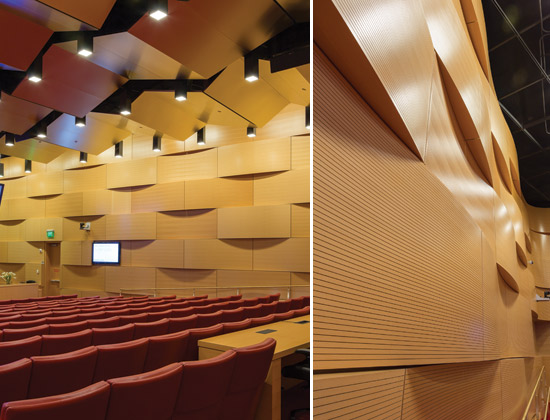Total Acoustical Design
Sound originates from a source such as a person talking at one basic frequency or music playing across multiple frequencies. When the sound travels to the ears of a listener, its loudness will be determined first by its original dB level then by things that can diminish it such as distance or surroundings. Whatever the makeup, it is first heard as direct sound traveling straight from the source to the listener. However, since sound radiates in all directions, it can also be affected by anything else nearby that it might reach, such as walls, floors, ceilings, etc.
Hence the full sound heard by a person within a space will be a combination of direct sound from the sources and sound reflected off the various surfaces within the space. Surfaces that are highly reflective of sound will cause it to reverberate or “bounce” back and can create an echo effect or a perception of a “very noisy” space. By contrast, surfaces that are highly sound absorptive will diminish the reflected sound waves, reduce loudness, reverberation and echoes, and help create a “quieter space.” Finding the right combination of sound absorption versus reflection for a given space is a matter of using several well-developed tools to balance the preferred acoustic characteristics within that space.
Noise Reduction Coefficient (NRC)
Individual materials can be formally tested according to ASTM C423 to measure the sound absorption rate of those materials on a scale of zero to one. Since the test determines sound absorption rates at four specific sound frequencies (250, 500, 1,000 and 2,000 Hz), the NRC rating number is actually an average of the results across those four frequencies which are generally in the range of human speech. Hence, a material with an NRC of 0.0 can be presumed to reflect back all of the sound striking it in this range (i.e. not absorb any) while a material with an NRC of 1.0 is represented to absorb all of the sound that strikes it in this range. The NRC is useful for determining the sound-absorbing characteristics of materials in many general building applications, but not for special applications where sound at other frequencies needs to be addressed.
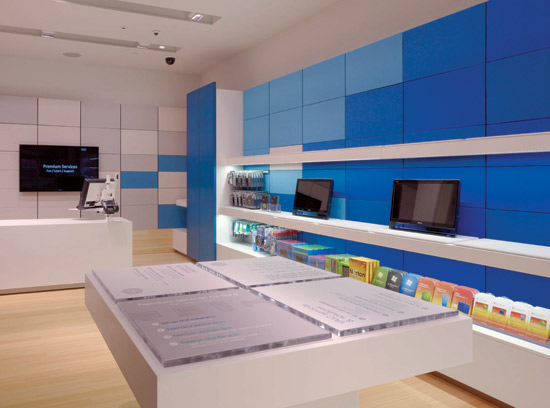
Photo courtesy of Owens Corning
Treating interior walls with high NRC-rated sound-absorptive materials helps reduce reverberation time in rooms where speech intelligibility is important.
Reverberation Time (RT)
Moving from materials to a space or room, RT is used as a measure of the persistence of sound after it originates within a room. It is measured as the time in seconds that it takes for the sound level to decay by 60 dBs. Controlling or minimizing RT is particularly important in rooms where people are listening to someone speaking since it directly affects the ability to understand the spoken word, which is referred to as “speech intelligibility.” Long reverberation times mean that the listener will be subjected to reflected sound with long delay times relative to the direct sound from the talker, and these late reflections will result in “overlaps” of spoken words, making it more difficult to understand. Note that RT is also frequency specific, meaning that different frequencies can have longer or shorter signatures within the same space.
Sabin
This is the measure of the total sound absorption provided by an individual sound absorber such as a ceiling baffle when installed within an architectural space. Absorption in Sabin is measured according to ASTM C423. The number of Sabin per unit is approximately equal to the total surface area of the unit (in square feet) that is exposed to sound, multiplied by the absorption coefficient of the material.
Sound Management: Controlling Sound Within a Space
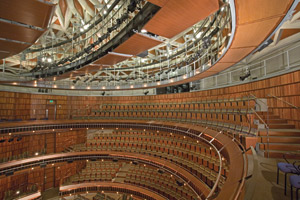
Photo courtesy of Rulon International
Sound radiates throughout a space and will be influenced by the size and shape of the space as well as the materials it encounters before it is heard by listeners.
Recognizing that sound will react not only to the room size and shape but also to the materials used in a room or space then we can also recognize our ability to control that reaction by design. The details of how to optimize that design will vary by use of course (e.g. a small classroom has different needs than a large auditorium or concert hall) but the basic principles and tools will be the same. First of all, it will be critically important to pay attention to the sound qualities of all materials exposed in the space such as ceiling treatments, wall coverings, and floor surfaces. All of these will have a range of sound absorption properties (whether tested or not) and will contribute to the overall RT of the room.
When addressing interior design, it is often the case that designers and acoustical consultants struggle with trade-offs between aesthetic preferences and acoustical performance. But that no longer needs to be the case. Innovators in the ceiling and wall panel industry have brought many new material options to suit the demands of architects, interior designers, and acousticians alike. Further, by offering custom solutions with variable acoustical options, product manufacturers are making it easier for architects to work together with their acoustic consultants in a more comprehensive approach. Some of these choices and innovations are discussed further as follows.
Sound Absorbers
Spaces that need to control reverberation times in rooms are typically in need of sound-absorptive materials with high NRC ratings. Toward that end, manufacturers offer a full range of high-performance, high-style acoustical wall and ceiling solutions for commercial interiors. These can include standard and custom acoustical wall panels made of fabric, fibrous materials, mineral tile, or acoustically treated wood products. They are available in a full range of sizes, shapes, and colors and can significantly reduce echoes and reverberation in a room while still enhancing an overall interior design scheme.
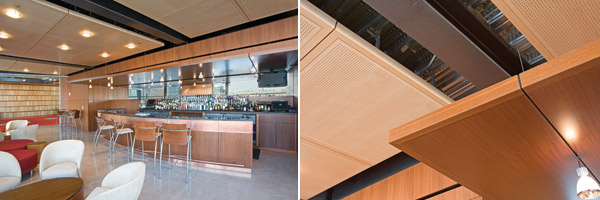
Photos courtesy of Rulon International
Acoustically treated wood ceiling panels are used in this public area to balance sound absorption and reflection. Perforated panels contain acoustical material behind for high absorption while solid wood panels offer the right level of sound reflection.
Sound absorption can also be applied to ceilings in the form of absorptive panels that can similarly be configured a variety of ways. Rather than being limited to suspended acoustic ceiling tile, there are many more options available to a designer today. These include free floating panel sections referred to as “clouds” that can be sized to suit the acoustic needs of the space while adding a visual focal point to the space. It is also possible to add a three-dimensional aspect to the ceiling with undulating or sculpted sections of sound-absorptive material. In tall spaces, hanging vertically oriented baffles that are designed to soak up sound and stop echoes is an option. They too can become design focal points by adding color, patterns, and visual interest to an otherwise plain ceiling space. In situations where a smooth, flat ceiling is desired, but more sound absorption than a gypsum board ceiling provides is required, there are some specialty options. For example, a European product that is also available in the U.S. offers a wide-span acoustical wall and ceiling system that is custom-installed by certified professionals and conceals its hardware for a smooth monolithic appearance. Systems like this provide the appearance of painted plaster or gypsum, yet offer superior sound absorption control.
Notice

www.ceilingsplus.com

OCBuildingSpec.com
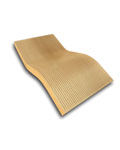
rulonco.com






